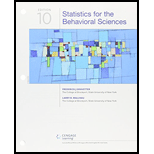
Concept explainers
- In a classic study, Loftus and Palmer (1974) investigated the relationship between memory for eyewitnesses and the question they are asked.
In the study participants watched a film of an automobile accident and then were questioned about the accident. One group was asked how fast the cars were going when they “smashed into” each other.
A second group was asked about the speed when the cars “hit” each other, and a third group was not asked any question about the speed of the cars. A week later, the participants returned to answer additional questions about the accident, including whether they recalled. Seeing any broken glass. Although there was no broken glass in the film, several students claimed to remember seeing it. The following table shows the frequency distribution of response for each group.
Response to the Question
Did You See Any Broken Glass?
Verb Used to Ask About the Speed
Verb Used as Ask About the Speed
Smashed into Hit
Control (Not Asked)
Response About Broken Glass
Yes No
- Does the proportion of participants who claim to remember broken glass differ significantly from group to group? Test with a = .05.
- Compute Cramer’s V to measure the size of the treatment effect.
The relationship between memory for eyewitness and the questions they were asked.
Answer to Problem 13P
Solution:
a) The test statistic of 7.778 is greater that the critical value of 5.991, hence, we reject the null hypothesis.
b) The Cramer's V obtained is 0.228.
c) The influence of the phrasing of the question on the participant's memeories is explained
d) A sentence demonstrating the outcome of the hypothesis test and the measure of effect size to be reported in a journal article is provided.
Explanation of Solution
a) Null Hypothesis H0: The memory for eyewitness and the question they were asked is independent. Alternate Hypothesis Ha: The memory for eyewitness and the question they asked is not independent.
Using the
The test statistic is
 number of cells
number of cells
The expected frequencies are calculated as
 &
&  are the
are the  cell's corresponding row & column total.
cell's corresponding row & column total.
| Response To | Broken Glass | Total | |||
| Yes | No | ||||
| Smashed Into | | | | | |
| Hit | | | | | |
| Control (Not asked) | | | | | |
| Total | | | |
The observed value of the test statistic is:
The critical value from the
b) Cramer's V is calculated as
 &
&  are the number of columns and rows respectively.
are the number of columns and rows respectively.
c) The phrasing of the question has a significant influence on the memory of the eyewitness. We can see this from both the Chi square test and Cramer's V that there is a moderately strong association between the eyewitness and the questions asked, and the way the question is phrased might change the way an eyewitness answers it.
d) From the result of the hypothesis testing, we can see that there is a significant relationship between the eyewitness and the question they were asked. We know this as the the test satstistic is greater than the critical value allowing us to reject null hypothesis. The measure of the relationship can be obtained from the result of the Cramer's V. We can also see from the Cramer's V of 0.228, that the association between the variables is moderately strong (0.20-0.25).
Conclusion:
We conclude that the memory for eyewitness and the question they were asked are dependent, i.e. the proportion of participants who claim to remember broken glass differ significantly from group to group at 5% level of significance.
Justification:
As the observed value of the test statistic is greater than the critical value, we reject
Want to see more full solutions like this?
Chapter 17 Solutions
Bundle: Statistics for the Behavioral Sciences, Loose-leaf Version, 10th + MindTap Psychology, 1 term (6 months) Printed Access Card
 Functions and Change: A Modeling Approach to Coll...AlgebraISBN:9781337111348Author:Bruce Crauder, Benny Evans, Alan NoellPublisher:Cengage Learning
Functions and Change: A Modeling Approach to Coll...AlgebraISBN:9781337111348Author:Bruce Crauder, Benny Evans, Alan NoellPublisher:Cengage Learning Glencoe Algebra 1, Student Edition, 9780079039897...AlgebraISBN:9780079039897Author:CarterPublisher:McGraw Hill
Glencoe Algebra 1, Student Edition, 9780079039897...AlgebraISBN:9780079039897Author:CarterPublisher:McGraw Hill Big Ideas Math A Bridge To Success Algebra 1: Stu...AlgebraISBN:9781680331141Author:HOUGHTON MIFFLIN HARCOURTPublisher:Houghton Mifflin Harcourt
Big Ideas Math A Bridge To Success Algebra 1: Stu...AlgebraISBN:9781680331141Author:HOUGHTON MIFFLIN HARCOURTPublisher:Houghton Mifflin Harcourt



